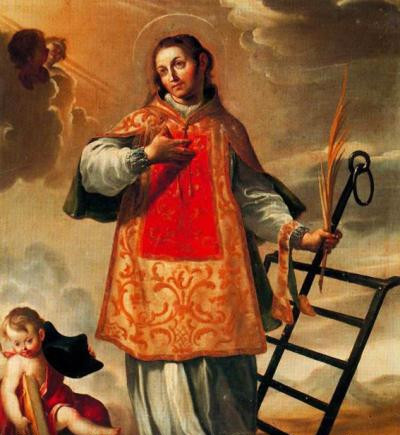
Saint of the Day for 10 August: St Lawrence
Martyr and Patron of the Poor, a Hero of the Faith between Legend and History
Name
St Lawrence
Title
Deacon and martyr
Birth
226, Osca, Spain
Death
10 August 258, Rome
Recurrence
10 August
Martyrology
2004 edition
Prayer
O glorious Saint Laurence, by zeal of Christianity, made the first of the seven deacons of the Roman Church, who with holy intrepidity endured the torments of martyrdom by fire on a fiery gridiron, because sustained by living Faith and ardent love for our Lord Jesus Christ, obtain for us also the grace to endure the hardships of this life and to remain steadfast in the profession of the Faith to merit a blessed eternity in Paradise. So be it.
Patron of
Perugia, Grosseto, Tivoli, Collegno, Alba, Montevarchi, Monserrato, Abano Terme, Borgo San Lorenzo, Budrio
Protector of
Librarians, cooks, permanent deacons, glassworkers, booksellers, pastry chefs, firemen, dreamers, vermicelliers
Roman Martyrology
Feast of St Lawrence, deacon and martyr, who, wishing, as St Leo the Great relates, to share the fate of Pope Sixtus even in martyrdom, having been ordered to hand over the treasures of the Church, showed the tyrant, mocking him, the poor, whom he had fed and fed with alms. Three days later he conquered the flames for faith in Christ and in honour of his triumph the instruments of martyrdom also migrated to heaven. His body was laid to rest in Rome in the Verano cemetery, then named after him.
The Saint and Mission
St Lawrence, deacon and martyr, is an emblematic figure when it comes to mission within the Church. His life, dedicated to the service of the poor and the defence of the faith, is a model of how Christian mission is expressed in love and witness. St Lawrence lived in Rome in the 3rd century AD at a time of intense persecution against Christians. As a deacon, he had the task of assisting the Pope in the management of the Church’s finances and in caring for the poor. Despite the dangerous context, Laurence carried out his mission with dedication and courage, witnessing the love of Christ through his actions. The climax of St Lawrence’s mission occurred when the Roman Emperor ordered the riches of the Church to be handed over. St Lawrence, in response, presented the poor, the sick, orphans and widows, declaring that these people, and not gold or silver, were the true riches of the Church. This act of courage and faithfulness to the Christian mission of serving the poor cost Lorenzo his life, but his testimony has remained as a shining example of dedication to the evangelical mission. St Lawrence shows us that the Christian mission is not only proclaiming the Gospel with words, but also and above all with works. His life challenges us to see Christ in the poor and to serve him through our love and dedication to them.
The Saint and Mercy
St Lawrence, deacon and martyr of the early Church, is one of the most venerated saints in the Catholic tradition. His life and martyrdom testify to a profound understanding and practice of Christian mercy. Remembered as one of the seven deacons of Rome, Lawrence had the task of assisting the bishop in the management of Church property and in helping the poor. In this role, Lawrence demonstrated an extraordinary commitment to mercy, generously distributing the Church’s wealth to those in need. The best known legend about Saint Lawrence concerns his martyrdom. When he was asked to hand over the riches of the Church to the Roman emperor, Lawrence took a group of poor, crippled, orphans and widows with him, declaring that they were the true riches of the Church. This act of defiance and compassion for those most in need is a powerful example of mercy in action. St Lawrence reminds us that mercy is not just a feeling, but a concrete action of love towards those in need. His life and martyrdom challenge us to see in the poor and the needy the true riches of the Church and to respond with generosity and compassion to the suffering of the world.
Hagiography
He was born in Osca in Spain in 226 of very noble and holy parents. So many were the gifts he received in the Sacraments of Baptism, Confirmation and the Eucharist, that he seemed prevented by grace; while still a child he always abstained from all childish amusements and was a model of docility and holy innocence to all. Having received his first education at home, he went to Zaragoza to learn literature, and in this famous university his progress was so rapid and wonderful that he was considered the best of all students. At this time the Bishop of that city, seeing in him a…
